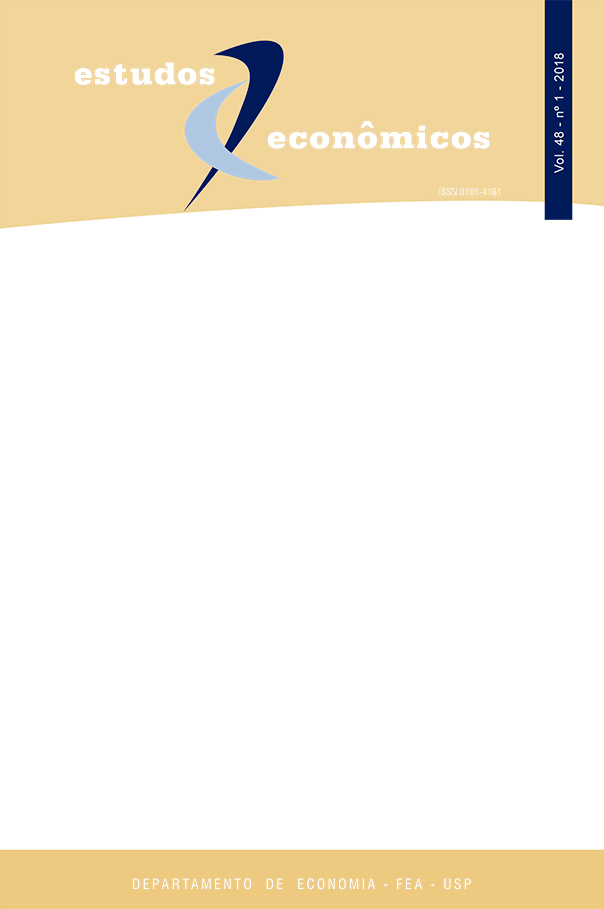Privatização: uma análise de bem-estar
DOI:
https://doi.org/10.1590/0101-41614832rppPalavras-chave:
Privatização, Infraestrutura, Bem-Estar, Modelo recursivo dinâmicoResumo
Este artigo utiliza um modelo dinâmico de equilíbrio geral para investigar impactos de bem-estar e alocativos de uma política de privatização da infraestrutura. A economia que se está modelando é composta de dois tipos de capital, um inerentemente privado e um outro com características de bens públicos, denominado infraestrutura, o qual é ofertado tanto pelo setor público quanto privado. Admitindo-se que este segundo tipo de capital gera efeitos externos positivos, a oferta pública de infraestrutura pode melhorar a alocação descentralizada desta economia. Porém, supondo que os impostos que financiam esta oferta e demais gastos públicos distorcem as decisões dos agentes, deprimindo o nível de bem-estar, a privatização da infraestrutura pode ser uma política satisfatória do ponto de vista social. As simulações indicam que os ganhos de bem-estar de uma política de privatização da infraestrutura dependem fortemente do grau de contribuição da oferta privada vis-à-vis a pública na geração de efeitos externos positivos.
Downloads
Referências
Ai, C., e Cassou S. P. 1995. “A Normative Analysis of Public Capital.” Applied Economics 27: 1201-1209.
Anuatti-Neto, F., Barossi-Filho, M., Carvalho, A. G. de, e Macedo, R. 2005. “Os efeitos da privatização sobre o
desempenho econômico e financeiro das empresas privatizadas”. Revista Brasileira de Economia 59(2): 151-175.
Aschauer, D. 1989. “Is Public Expenditure Productive?” Journal of Monetary Economics 23:177-200.
Calderón, C., e Servén, L. 2003. “Trends in Infrastructure in Latin America, 1980-2001.” Central Bank of Chile, Working Papers 269, September.
Privatização: Uma Análise de Bem-Estar 419 Estud. Econ., São Paulo, vol.48 n.3, p. 391-422, jul.-set. 2018
Cardoso, I. da C. V., Maia, A., Santos, S. M. dos, e Soares, F. De A. 2013. “O Impacto da Privatização no Desempenho Econômico: Um Estudo em Empresas Brasileiras de Grande Porte.” Revista Ibero-Americana de Estratégia 12:183-211.
Chari, V.V., Christiano, L, e Kehoe, P. 1995. “Policy Analysis in Business Cycle Models.” In Frontiers of Business Cycles Research, edited by T. F. Cooley, 12:357-391, Princeton, NY: Princeton University Press.
Cook, P., e Uchida, Y. 2003. “Privatization and economic growth in developing Countries.” Journal of Development Studies 39(6): 121-154.
Cooley, T. F. e Prescott, E. C. 1995. “Economic Growth and Business Cycles.” In Frontiers of Business Cycles Research, edited by T. F. Cooley, 1:1-38, Princeton, NY: Princeton University Press.
Duffy-Deno, K. e Eberts, R. W. 1991. “Public Infrastructure and Regional Economic Development: a Simultaneous Equations Approach.” Journal of Urban Economics 30: 329-343.
Easterly, W. e Rebelo, S. 1993. “Fiscal Policy and Economic Growth: an Empirical Investigation.” Journal of Monetary Economics 32(3): 417-458.
Ferreira, P. 1998. “Public versus Private Provision of Infrastructure in a Neoclassical Growth Model.” Fundação Getúlio Vargas, Ensaios Econômicos EPGE 339.
Ferreira, P. e Nascimento, L. G. 2005. “Welfare and Growth Effects of Alternative Fiscal Rules for Infrastructure Investment in Brazil.” Fundação Getúlio Vargas, Ensaios Econômicos EPGE 604.
Filipovic, A. 2006. “Impact of Privatization on Economic Growth.” Undergraduate Economic Review 2(1), 7.
Glomm, G. e Ravikumar, B. 1994. “Public Investment in Infrastructure in a Simple Growth Model.” Journal of Economic Dynamics and Control 18(6):1173-1187.
Gylfason, T. 2007. “Privatization, Efficiency, and Economic Growth”. In The Socio-Economic Transformation edited by Z. Nahorski, J. W. Owsiński, e T. Szapiro. London: Palgrave Macmillan.
Holtz-Eakin, D. 1992. “Public Sector Capital and Productivity Puzzle.” NBER, Working Paper 4122.
Hulten, C. e Schwab, R. 1992. “Public Capital Formation and the Growth of Regional Manufacturing Industries.”
National Tax Journal 45(4): 121-143.
Hulten, C. 1996. “Infrastructure Capital and Economic Growth: How Well Use It May Be More Important Than How Much You Have.” NBER, Working Paper 5847.
McGrattan, E. R. e Prescott, E. C. 2005. “Productivity and the post-1990 U.S. economy.” Federal Reserve Bank of St. Louis Review 87(4):537-49.
Megginson, W., e Netter, J. 2001. “From State to Market: A Survey of Empirical Studies on Privatization.” Journal of Economic Literature 39(2): 321-389.
Pereira, R. A. de C. e Ferreira, P. C. 2008. “Efeitos de crescimento e bem-estar da Lei de Parceria Público-Privada no Brasil.” Revista Brasileira de Economia 62(2):207-219.
Pritchett, L. 2000. “The Tyranny of Concepts: CUDIE (Cumulated, Depreciated, Investment Effort) is Not Capital.” Journal of Economic Growth 5 (4): 367-391.
Rahbar, F., Sargolzaei, M., Ahmadi, R. e Ahmadi, M. 2012. “Investigating the Effects of Privatization on the Economic Growth in Developing Countries: A Fixed Effects Approach.” Journal of Economics and Sustainable Development 3 (4): 61-66.
Schmitz, J. A. Jr. 2001. “Government Production of Investment Goods and Aggregate Labor Productivity.” Journal of Monetary Economics 47(1):163-87.
Schmitz, J. A. Jr e Teixeira, A. 2004. “Privatization’s Impact on Private Productivity: The Case of Brazilian Iron Ore.” Federal Reserve Bank of Minneapolis, Staff Report 337.
Shukurov, S., Maitah, M. e Smutka, L. 2016. “The Impact of Privatization on Economic Growth: The Case of Uzbekistan.” International Journal of Economics and Financial Issues 6(3): 948-957.
Suescún, R. 2005. “Fiscal Space for Investment in Infrastructure in Colombia.” World Bank Policy Research, Working Paper 3629, June.
Downloads
Publicado
Edição
Seção
Licença
Copyright (c) 2018 Ricardo A de Castro Pereira, Pedro Cavalcanti Ferreira

Este trabalho está licenciado sob uma licença Creative Commons Attribution-NonCommercial 4.0 International License.
A submissão de artigo autoriza sua publicação e implica o compromisso de que o mesmo material não esteja sendo submetido a outro periódico.
A revista não paga direitos autorais aos autores dos artigos publicados.





 Atualizado em 14/08/2025
Atualizado em 14/08/2025